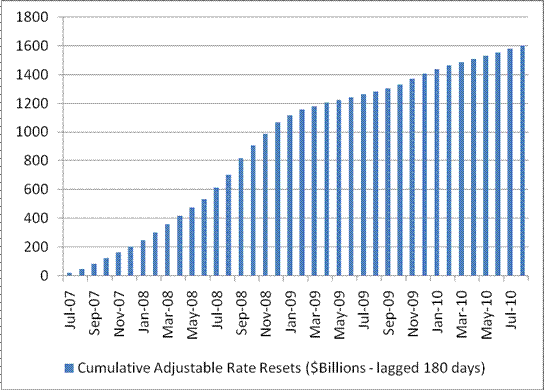Foreclosure foreplay?
U.S. Foreclosures Jump 57% as Homeowners Walk Away (Update3)By Dan Levy
and bank repossessions more than doubled in March from a year earlier as adjustable mortgages increased and more owners lost their homes to lenders.
More than 234,000 properties were in some stage of foreclosure
Auction notices rose 32 percent from a year ago, a sign that more defaulting homeowners are "simply walking away...."
U.S. home price declines will probably double to a national average of 20 percent by next year, with lower values most likely in metropolitan areas in California, Florida, Arizona and Nevada, mortgage insurer PMI Group Inc. said last week in a report.
Bank seizures climbed 129 percent from a year earlier, according to RealtyTrac, which has a database of more than 1 million properties and monitors foreclosure filings including defaults notices, auction sale notices and bank repossessions. March was the 27th consecutive month of year-on-year monthly foreclosure increases. In February, foreclosure filings rose 60 percent.
Is this as bad as it gets?
Not according to John Hussman:
Among the latest topics of opinion is how far the mortgage crisis has to go. Evidently, the idea is that the recession that these analysts didn't forecast is already over, so it is time to “look across the valley” on the belief that most of the writedowns are behind us.
A good way to estimate where we are in the process of writedowns and foreclosures is to revisit the schedule of resets for adjustable rate mortgages.
it is important to recognize the foreclosure timeline. Once a reset occurs, it takes up to 30 days for the first payment to be missed. After 90 days of attempts to catch up on missed payments, the homeowner is served with a “Notice of Default.” It then takes another 90 days with the homeowner in default for a “Notice of Trustee Sale” to be delivered, shortly after which the property is sold in a foreclosure. In short, there is generally a span of about 6 months from reset to foreclosure, which means that we have to lag the data to get the profile of anticipated loan losses.
That produces the following profile for the cumulative losses that can be expected. Again, these are not dollar amounts, since only a portion of even sub-prime mortgages will default. While we will also undoubtedly observe losses from credit cards, commerical real estate, and home equity loans, the point here is only about the general shape of the cumulative loss curve [View his chart below].
Clearly, as we enter April 2008, we appear to be quite early in the mortgage crisis, with only about a quarter of the cumulative resets having occurred.
Moreover, because of the bundling, securitization*, and slicing and dicing of mortgage obligations, financial companies have little ability to take the required writedowns in advance, because they don't know yet which ones will go into default. To opine that we are in some late “inning” of the mortgage problem, without reference to the reset data, is just naïve. If anything, the probable rate of foreclosure on later resets will be higher, not lower, than the earlier resets, because those later resets represent the mortgages initiated at the peak of home prices and the trough of lending standards.


0 Comments:
Post a Comment
<< Home